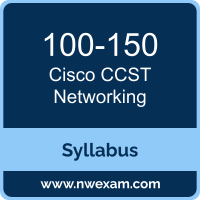 A great way to start the Cisco Certified Support Technician (CCST) Networking preparation is to begin by properly appreciating the role that syllabus and study guide play in the Cisco 100-150 certification exam. This study guide is an instrument to get you on the same page with Cisco and understand the nature of the Cisco CCST Networking exam.
A great way to start the Cisco Certified Support Technician (CCST) Networking preparation is to begin by properly appreciating the role that syllabus and study guide play in the Cisco 100-150 certification exam. This study guide is an instrument to get you on the same page with Cisco and understand the nature of the Cisco CCST Networking exam.
Our team of experts has composed this Cisco 100-150 exam preparation guide to provide the overview about Cisco Certified Support Technician (CCST) Networking exam, study material, sample questions, practice exam and ways to interpret the exam objectives to help you assess your readiness for the Cisco CCST Networking exam by identifying prerequisite areas of knowledge. We recommend you to refer the simulation questions and practice test listed in this guide to determine what type of questions will be asked and the level of difficulty that could be tested in the Cisco CCST Networking certification exam.
Cisco 100-150 Exam Overview:
|
Exam Name
|
Cisco Certified Support Technician (CCST) Networking |
| Exam Number | 100-150 CCST Networking |
| Exam Price | $125 USD |
| Duration | 50 minutes |
| Number of Questions | 40-50 |
| Passing Score | Variable (750-850 / 1000 Approx.) |
| Recommended Training | Network Technician |
| Exam Registration | PEARSON VUE |
| Sample Questions | Cisco 100-150 Sample Questions |
| Practice Exam | Cisco Certified Support Technician (CCST) Networking Practice Test |
Cisco 100-150 Exam Topics:
| Section | Objectives |
|---|---|
|
Standards and Concepts
|
- Identify the fundamental conceptual building blocks of networks.
- Differentiate between bandwidth and throughput.
- Differentiate between LAN, WAN, MAN, CAN, PAN, and WLAN.
- Compare and contrast cloud and on-premises applications and services.
- Describe common network applications and protocols.
|
| Addressing and Subnet Formats |
- Compare and contrast private addresses and public addresses.
- Identify IPv4 addresses and subnet formats.
- Identify IPv6 addresses and prefix formats.
|
| Endpoints and Media Types |
- Identify cables and connectors commonly used in local area networks.
- Differentiate between Wi-Fi, cellular, and wired network technologies.
- Describe endpoint devices.
- Demonstrate how to set up and check network connectivity on Windows, Linux, Mac OS, Android, and Apple iOS.
|
| Infrastructure |
- Identify the status lights on a Cisco device when given instruction by an engineer.
- Use a network diagram provided by an engineer to attach the appropriate cables.
- Identify the various ports on network devices.
- Explain basic routing concepts.
- Explain basic switching concepts.
|
| Diagnosing Problems |
- Demonstrate effective troubleshooting methodologies and help desk best practices, including ticketing, documentation, and information gathering.
- Perform a packet capture with Wireshark and save it to a file.
- Run basic diagnostic commands and interpret the results.
- Differentiate between different ways to access and collect data about network devices.
- Run basic show commands on a Cisco network device.
|
| Security |
- Describe how firewalls operate to filter traffic.
- Describe foundational security concepts.
- Configure basic wireless security on a home router (WPAx).
|
Cisco CCST Networking Exam Description:
The Cisco Certified Support Technician Networking (100-150) exam validates an individual’s skills and knowledge of entry-level networking concepts and topics. The certification demonstrates foundational knowledge and skills needed to show how networks operate, including the devices, media, and protocols that enable network communications
